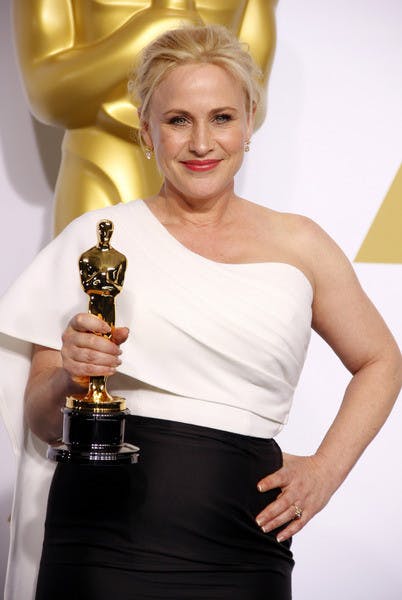In case you haven’t been on the Internet in the last 36 hours, Patricia Arquette is being celebrated for more than just her Oscar win for Best Supporting Actress in Boyhood.
During Sunday night’s live Academy Awards telecast, the seasoned performer stood up for women everywhere, making a rousing plea to take action about the notorious gender pay gap.
The problem of pay disparity between men and women in Hollywood was already in the public eye thanks to the high-profile cyber-attack against Sony last December.
The hacks made public several internal emails from former Sony Co-chairman Amy Pascal revealing a stark double-standard, chief among them a salary negotiation for the Oscar-winning film American Hustle that saw female co-stars Jennifer Lawrence and Amy Adams settling for 7 percent of profits as opposed to the 9 percent secured by their male counterparts.
It was also revealed that out of the 17 employees at Sony who make more than $1 million per year, only one is a woman, and according to a 2005 audit, 85 out of the top 100 earners at Sony Pictures were men.
Mind the gap
Lest you start to feel unsympathetic toward entertainment types making a million or two less, remind yourself it’s about disparity, not gross income. The pay gap is a real obstacle for all the non-Oscar winning women outside Hollywood too.
According to the most recent research from the American Association of University Women (AAUW), women can expect to earn, on average, 78 percent of what men take home.
According to state-by-state analysis based on U.S. Census, Department of Education, and Bureau of Labor Statistics data, they found that the best place for wage equality in America was Washington D.C., where women take home 91 percent of male earnings, and the worst was Louisiana, where the ratio is 66 percent.
Here are some more quick facts:
- The pay gap is worse for women of color – Hispanic women show the largest disparity, with 54 percent of white male earnings (the largest demographic in the workforce).
- The pay gap is present in nearly every occupation – Women are paid less than men even in female-dominated and gender-balanced professions.
- The pay gap exists among women without children – Full-time female workers one year removed from college graduation – nearly all of whom are childless – are paid just 82 percent of what their male counterparts make.
Making progress
The good news is that thanks to ongoing activism, awareness efforts, and the occasional rousing Oscar speech, remarkable progress has been made on getting women equal pay, and it’s something we are coming out of rather than running into.
The pay gap ratio for women has narrowed considerably since the 1970s from 57 percent to 78 percent, reflecting women’s progress in education and workforce participation. However, AAUW warns that progress has stalled in the last decade, and that the remaining portion of the gap is unlikely to close on its own.
Here’s what you can do to help:
- Conduct salary audits at your company to proactively monitor and address gender-based pay differences.
- Seek training in negotiation skills if you are a woman, because better negotiating means a smaller pay gap.
- Use AAUW resources to educate yourself about the realities of pay disparity, spread the word, and raise awareness.
Spurring an honest, open dialogue
While Arquette’s acceptance speech was powerful and timely, it took a massive cybersecurity breach on behalf of a major Hollywood studio to even broach the subject in good taste. Hopefully it will help spur a more honest and open dialogue.
While it’s an honor to be nominated, the wins matter, too.
This was originally published on the Michael C. Fina blog.
